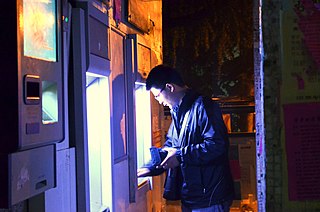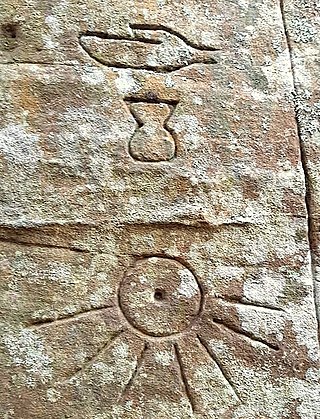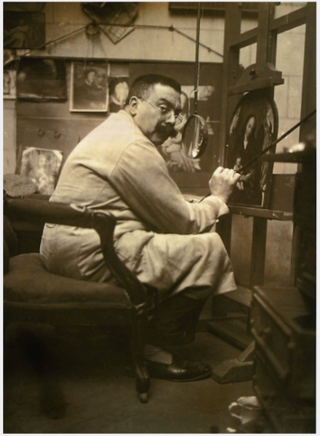
Authentication is the act of proving an assertion, such as the identity of a computer system user. In contrast with identification, the act of indicating a person or thing's identity, authentication is the process of verifying that identity. It might involve validating personal identity documents, verifying the authenticity of a website with a digital certificate, determining the age of an artifact by carbon dating, or ensuring that a product or document is not counterfeit.

Forgery is a white-collar crime that generally consists of the false making or material alteration of a legal instrument with the specific intent to defraud. Tampering with a certain legal instrument may be forbidden by law in some jurisdictions but such an offense is not related to forgery unless the tampered legal instrument was actually used in the course of the crime to defraud another person or entity. Copies, studio replicas, and reproductions are not considered forgeries, though they may later become forgeries through knowing and willful misrepresentations.

Thomas Patrick Keating was an English artist, art restorer and art forger. Considered the most prolific and versatile art forger of the 20th century, he claimed to have faked more than 2,000 paintings by more than 160 different artists of unprecedented scope—ranging from the Renaissance to Modernism, Expressionism and Fauvism —with heavy emphasis on English landscape Romanticists and the French Impressionists. Total estimated profits from his forgeries amount in today's value to more than $10 million.

Art forgery is the creation and sale of works of art which are intentionally falsely credited to other, usually more famous artists. Art forgery can be extremely lucrative, but modern dating and analysis techniques have made the identification of forged artwork much simpler.

Archaeological forgery is the manufacture of supposedly ancient items that are sold to the antiquities market and may even end up in the collections of museums. It is related to art forgery.
John Myatt,, is a British artist convicted of art forgery who, with John Drewe, perpetrated what has been described as "the biggest art fraud of the 20th century". After his conviction, Myatt was able to continue profiting from his forgery career through his creation of "genuine fakes".
Otto Wacker (1898–1970) was a German art dealer who became infamous for commissioning and selling forgeries of paintings by Vincent van Gogh. He had gained a good reputation in the 1920s after false starts in various other professions. Since the end of World War II, he lived in East Berlin. A study of his life and times has been written by Modris Eksteins.

Josephus Maria Van der Veken was a Belgian art restorer, copyist, and art forger who mastered the art of reproducing the works of early Netherlandish painters.

Geert Jan Jansen is a Dutch painter and art forger, who was arrested in 1994.

A catalogue raisonné is an annotated listing of the works of an artist or group of artists and can contain all works or a selection of works categorised by different parameters such as medium or period.

A replica is an exact copy or remake of an object, made out of the same raw materials, whether a molecule, a work of art, or a commercial product. The term is also used for copies that closely resemble the original, without claiming to be identical. Copies or reproductions of documents, books, manuscripts, maps or art prints are called facsimiles.

A certificate of authenticity (COA) is a seal or small sticker on a proprietary computer program, t-shirt, jersey, or any other memorabilia or art work, especially in the world of computers and sports. It is commonly a seal on paper authenticating a specific art work which and is made to demonstrate that the item is authentic.
Anthony Gene Tetro, known as Tony Tetro, is an art forger known for his perfectionism in copies of artwork produced in the 1970s and 1980s. Tetro never received formal art lessons, but learned from books, by painting and experimentation. Over three decades, Tetro forged works by Rembrandt, Joan Miró, Marc Chagall, Salvador Dalí and Norman Rockwell and others. Tetro's paintings and lithographs, known for their perfectionism, were sold by art dealers and auction houses as legitimate works and hang in museums, galleries around the world. He was caught after Hiro Yamagata found a forgery of his own work for sale in a gallery.
Karl Feoder Sim, also known as Carl Feoder Goldie was a New Zealand art forger, and the only person convicted of that crime in New Zealand.

Authenticity in art is manifested in the different ways that a work of art, or an artistic performance, can be considered authentic. The initial distinction is between nominal authenticity and expressive authenticity. In the first sense, nominal authenticity is the correct identification of the author of a work of art; of how closely an actor or an actress interprets a role in a stageplay as written by the playwright; of how well a musician's performance of an artistic composition corresponds to the composer's intention; and how closely an objet d’art conforms to the artistic traditions of its genre. In the second sense, expressive authenticity is how much the work of art possesses inherent authority of and about its subject, and how much of the artist's intent is in the work of art.
Wolfgang Beltracchi is a German former art forger and visual artist who has admitted to forging hundreds of paintings in an international art scam netting millions of euros. Beltracchi, together with his wife Helene, sold forgeries of alleged works by famous artists, including Max Ernst, Heinrich Campendonk, Fernand Léger, and Kees van Dongen. Though he was found guilty for forging 14 works of art that sold for a combined $45m (£28.6m), he claims to have faked "about 50" artists. The total estimated profits Beltracchi made from his forgeries surpasses $100m.
Technical art history is an interdisciplinary field of study at the cross-section of science and humanities in which an increasingly wide range of analytical tools is employed to shed light on the creative process from idea to artwork. Researchers from varying fields – among which art history, conservation, and conservation science – collaborate in an interdisciplinary manner to gain “a thorough understanding of the physical object in terms of original intention, choice of materials and techniques as well as the context in and for which the work was created, its meaning and contemporary perception.”
Peter Paul Biró (1954–2024) was a forensic art analyst, known for his work in authenticating paintings using fingerprint analysis. He was involved in several high-profile cases, including the authentication of works attributed to artists Jackson Pollock, Leonardo da Vinci, and Goodridge Roberts. Biro's techniques and conclusions were subjects of debate and scrutiny. In 2009, The New Yorker published an article that critically examined Biro's methods. Subsequently, Biro filed a defamation lawsuit against the magazine, the article's author, and others. The courts later dismissed the lawsuit.

Art Recognition is a technology company headquartered in Adliswil, within the Zurich metropolitan area, Switzerland. Specializing in the application of artificial intelligence (AI) for the purposes of art authentication and the detection of art forgeries, Art Recognition integrates advanced algorithms and computer vision technology. The company's operations extend globally, with the primary aim as a joint-stock-company to increase profit for its shareholders.

David Henty is a former master forger. His works are renowned for the accuracy and authenticity with which he paints perfect copies of original works by master painters. Henty copies works by Caravaggio, Pablo Picasso, Amadeo Modigliani, Vincent Van Gogh, Jean-Michel Basquiat and others. Many of Henty's forgeries have been sold by art dealers and auction houses as original works and are unknowingly included in many collections around the world. Having painted more copies of LS Lowry's work than Lowry himself, Henty now operates on the right side of the law. His paintings regularly sell for thousands of pounds.












